Atmospheric Circulation Patterns during the Summertime Precipitation in Southeastern Iran
Abstract
:1. Introduction
2. Materials and Methods
2.1. Study Area
2.2. Data
2.3. Methods
- The number of stations reporting precipitation on each rainy day should equal or exceed four.
- The spatial criterion (regional extent) stipulates that precipitation must have occurred in at least 50% of the study area (two quarters).
3. Results
3.1. Statistical Analysis of Summer Precipitation in Southeastern Iran
3.2. Extended Area Precipitation Events (EAPEs)
3.3. Cluster Analysis of Synoptic Situations during EAPEs
3.3.1. Subjective Method
3.3.2. Objective Method
3.4. Annual Frequency of EAPE
3.5. Case Studies
- 1.
- AP pattern (on the example of 25 May 1996)
- 2.
- BP pattern (on the example of 23 July 1995)
- 3.
- CP pattern (on the example of 8 August 2006)
- 4.
- DP pattern (on the example of 11 June 2005)
- 5.
- EP pattern (on the example of 31 July 2016)
3.6. Trajectory of Circulation Patterns
4. Discussion
5. Conclusions
Author Contributions
Funding
Institutional Review Board Statement
Informed Consent Statement
Data Availability Statement
Acknowledgments
Conflicts of Interest
References
- Barry, R.G.; Perry, A.H. Synoptic Climatology: Methods and Applications, 1st ed.; Routledge Kegan & Paul: London, UK, 1973; 552p. [Google Scholar]
- Barry, R.G.; Carleton, A.M. Synoptic and Dynamic Climatology, 1st ed.; Routledge: New York, NY, USA, 2001; 640p. [Google Scholar] [CrossRef]
- Barry, R.G.; Chorley, R.J. Atmosphere, Weather and Climate, 1st ed.; Taylor & Francis: London, UK, 2009; 536p. [Google Scholar] [CrossRef]
- Vasquez, T. Weather Analysis & Forecasting Handbook, 1st ed.; Weather Graphics Technologies: Palestine, TX, USA, 2015. [Google Scholar]
- Abbasi, E.; Etemadi, H.; Smoak, J.M.; Amouniya, H.; Mahoutchi, M.H. Dust storm source detection using ANP and WRF models in southwest of Iran. Arab. J. Geosci. 2021, 14, 1529. [Google Scholar] [CrossRef]
- Rahimi, Y.G.; Abbasi, E.; Farajzadeh, M. Analysis of the effect of Tropical Cyclone Phet on the occurrence of heavy rainfall and floods in Chabahar, Iran. Weather 2015, 70, 348–352. [Google Scholar] [CrossRef]
- Rousta, I.; Khosh Akhlagh, F.; Soltani, M.; Modir Taheri, S.S. Assessment of Blocking Effects on Rainfall in Northwestern Iran; Kanakidou, M., Mihalopoulos, N., Nastos, P., Eds.; Crete University Press: Iraklio, Greek, 2014; Volume 1. [Google Scholar]
- Rousta, I.; Moniruzzaman, M.; Olafsson, H.; Zhang, H.; Baranowski, P.; Tkaczyk, P.; Lipińska, H.; Kępkowicz, A.; Krzyszczak, J. Investigation of the Vegetation Coverage Dynamics and its Relation to Atmospheric Patterns in Kabul River Basin in Afghanistan. Pure Appl. Geophys. 2022, 179, 3075–3094. [Google Scholar] [CrossRef]
- Abbasi, E.; Etemadi, H.; Smoak, J.M.; Rousta, I.; Olafsson, H.; Baranowski, P.; Krzyszczak, J. Investigation of atmospheric conditions associated with a storm surge in the south-west of Iran. Atmosphere 2021, 12, 1429. [Google Scholar] [CrossRef]
- Fiddes, S.L.; Pezza, A.B.; Barras, V. Synoptic climatology of extreme precipitation in alpine Australia. Int. J. Clim. 2015, 35, 172–188. [Google Scholar] [CrossRef]
- Chen, T.C.; Tsay, J.D.; Matsumoto, J. Interannual variation of the summer rainfall center in the South China Sea. J. Clim. 2017, 30, 7909–7931. [Google Scholar] [CrossRef]
- Webster, P.J.; Toma, V.E.; Kim, H.M. Were the 2010 Pakistan floods predictable? Geophys. Res. Lett. 2011, 38, L04806. [Google Scholar] [CrossRef]
- Wu, G.; Liu, Y.; He, B.; Bao, Q.; Duan, A.; Jin, F.F. Thermal controls on the asian summer monsoon. Sci. Rep. 2012, 2, 404. [Google Scholar] [CrossRef] [PubMed]
- Wang, Z.; Yang, S.; Duan, A.; Hua, W.; Ullah, K.; Liu, S. Tibetan Plateau heating as a driver of monsoon rainfall variability in Pakistan. Clim. Dyn. 2019, 52, 6121–6130. [Google Scholar] [CrossRef]
- Ullah, W.; Guojie, W.; Gao, Z.; Tawia Hagan, D.F.; Bhatti, A.S.; Zhua, C. Observed Linkage between Tibetan Plateau Soil Moisture and South Asian Summer Precipitation and the Possible Mechanism. J. Clim. 2021, 34, 361–377. [Google Scholar] [CrossRef]
- Yang, Y.; Wang, R.; Chen, F.; Liu, C.; Bi, X.; Huang, M. Synoptic weather patterns modulate the frequency, type and vertical structure of summer precipitation over Eastern China: A perspective from GPM observations. Atmos. Res. 2021, 249, 105342. [Google Scholar] [CrossRef]
- Yamada, T.J.; Takeuchi, D.; Farukh, M.A.; Kitano, Y. Climatological characteristics of heavy rainfall in northern Pakistan and atmospheric blocking over western Russia. J. Clim. 2016, 29, 7743–7754. [Google Scholar] [CrossRef]
- Raghavan, K.; Sabin, T.P.; Mujumdar, M.; Priya, P. Extreme monsoon precipitation events over South Asia in a warming world. Geophys. Res. Abstr. 2012, 14, EGU2012-7293. [Google Scholar]
- Kaviani, M.R. A statistical analysis of Iran’s rainfall regime. J. Geogr. Educ. Growth 1988, 1, 4–12. [Google Scholar]
- Mofidi, A. The Analysis of Summertime Atmospheric Circulation over Iran and It’s Relation to Summertime Precipitation in Iran Plateau. Ph.D. Thesis, Tarbiat Moallem University, Tehran, Iran, 2007; 165p. [Google Scholar]
- Alijani, B. Iran Climate; Payame Noor University Press: Tehran, Iran, 2018; 224p. [Google Scholar]
- Snead, R.E. Weather patterns in southernwest Pakistan. Arch. Meteorol. Geophys. Bioclimatol. 1968, 16, 316–346. [Google Scholar] [CrossRef]
- Sawyer, J.S. The structure of the intertropical front over N.W. India during the S.W. Monsoon. Q. J. R. Meteorol. Soc. 1947, 73, 346–369. [Google Scholar] [CrossRef]
- Taghizadeh, H. Analysis of rainfall on 1 August 1987. J. Geol. Educ. Growth 1987, 1, 26–37. [Google Scholar]
- Parvand, H. The Effect of Southwestern Monsoon on Iran. Dissertation, University of Tehran, Tehran, Iran, 1991. [Google Scholar]
- Junbakhsh, H.A. Synoptic Investigation of Floods in Lar City. Master’s Thesis, Institute of Geophysics, University of Tehran, Tehran, Iran, 1995; 160p. [Google Scholar]
- Saligheh, M. Dynamic interaction of mid-latitudes and low latitudes pressure systems in Iran. J. Growth Educ. Geogr. 2001, 57, 21–24. [Google Scholar]
- Saligheh, M. Synoptic pattern of summer rainfall in southeastern of Iran. Geogr. Res. Q. 2001, 16, 114–125. [Google Scholar]
- Saligheh, M. Modeling the effects of low-pressure climate in the subtropical region. Geogr. Res. Q. 2003, 70, 74–90. [Google Scholar]
- Arabi, Z. Synoptic analysis of rainfall from July 21 to 26, 1999 in Iran. Geogr. Res. Q. 2006, 38, 1–16. [Google Scholar]
- Saligheh, M. Precipitation mechanisms in the southeast of the country. J. Geogr. Res. 2006, 55, 1–13. [Google Scholar]
- AfsharManesh, H. Synoptic Analysis of Summer Precipitation in Southeastern of Iran. Master’s Thesis, University of Tehran, Tehran, Iran, 2010; 145p. [Google Scholar]
- Alijani, B.; Mofidi, A.; Jafarpour, Z.; Aliakbari-Bidokhti, A. Circulation patterns of monsoon rains in Iran during July 1994. J. Appl. Res. Geogr. Sci. 2008, 7, 7–38. [Google Scholar]
- Alijani, B.; Mofidi, A.; Aliakbari-Bidokhti, A. Atmospheric circulation patterns of the summertime rainfalls of southeastern Iran during July 1994. J. Earth Sp. Phys. 2011, 37, 205–227. [Google Scholar]
- Abkharabat, S.; Rezaeibanafsheh, M.; Jahanbakhsh-Asl, S.; Karimi, M.; Rasouli, A.A. Dynamical- synoptical analysis of summer precipitation process in Southeast Iran. Phys. Geogr. Res. Q. 2016, 48, 335–349. [Google Scholar] [CrossRef]
- Armesh, M.; Khosravi, M.; Saligheh, M. Synoptic Study of the Influence of Monsoon System in South-East Iran. Clim. Chang. Hazards 2019, 1, 102–135. [Google Scholar]
- KhoshAkhlagh, F.; Azizi, G.; Lashkari, H.; Mahoutchi, M.H. Analysis of the Synoptic-Dynamic Patterns of Inclusive Summer Super-Heavy Rainfalls in Southeast Of Iran. Geogr. Plan. Sp. 2019, 9, 185–202. [Google Scholar] [CrossRef]
- NCC-a. Atlas of Maps and Spatial Information “Sistan and Baluchestan Provice”; National Cartographic Center (NCC): Tehran, Iran, 2018. Available online: https://www.ncc.gov.ir/en/ (accessed on 18 April 2023).
- NCC-b. Atlas of Maps and Spatial Information “Kerman Provice”; National Cartographic Center (NCC): Tehran, Iran, 2018. Available online: https://www.ncc.gov.ir/en/ (accessed on 18 April 2023).
- NCC-c. Atlas of Maps and Spatial Information “Hormozgan Provice”; National Cartographic Center (NCC): Tehran, Iran, 2018. Available online: https://www.ncc.gov.ir/en/ (accessed on 18 April 2023).
- Mohammadi, M.; Sobhani, B. Relative Humidity Zoning of Sistan-Baluchestan Province Using MODIS Satellite Images. Iran. J. Soil Water Res. 2020, 51, 2681–2695. [Google Scholar] [CrossRef]
- NDWMC-a. Yearbook of the National Center for Climate and Drought Crisis Management; National Drought Warnin and Monitoring Center (NDWMC): Tehran, Iran, 2021. Available online: http://ndc.irimo.ir (accessed on 28 April 2023).
- NDWMC-b. Country Temperature Bulletin; National Drought Warnin and Monitoring Center (NDWMC): Tehran, Iran, 2021. Available online: http://ndc.irimo.ir (accessed on 3 May 2023).
- AlaeeTaleghani, M. Geomorphology of Iran; Ghoomes Pulishing Company: Tehran, Iran, 2017; 360p. [Google Scholar]
- Raju, P.V.S.; Mohanty, U.C.; Bhatla, R. Onset characteristics of the southwest monsoon over India. Int. J. Climatol. 2005, 25, 167–182. [Google Scholar] [CrossRef]
- Pai, D.S.; Rajeevan, M. Prediction of summer monsoon onset over Summer monsoon onset over Kerala. J. Earth Syst. Sci. 2009, 118, 123–135. [Google Scholar] [CrossRef]
- Puviarasan, N.; Sharma, A.K.; Ranalkar, M.; Giri, R.K. Onset, advance and withdrawal of southwest monsoon over Indian subcontinent: A study from precipitable water measurement using ground based GPS receivers. J. Atmos. Sol.-Terr. Phys. 2015, 122, 45–57. [Google Scholar] [CrossRef]
- IMD India Meteorological Department. Ministry of Earth Sciences, Government of India. Published 2021. Available online: https://mausam.imd.gov.in/ (accessed on 5 June 2023).
- Zeng, X.; Lu, E. Notes and Correspondence: Globally unified monsoon onset and retreat indexes. J. Clim. 2004, 17, 2241–2248. [Google Scholar] [CrossRef]
- Fasullo, J.; Webster, P.J. A hydrological definition of Indian Monsoon onset and withdrawal. J. Clim. 2003, 16, 3200–3211. [Google Scholar] [CrossRef]
- Singh, N.; Ranade, A. Determination of Onset and Withdrawal Dates of Summer Monsoon across India Using NCEP/NCAR Re-Analysis; Indian Institute of Tropical Meteorology: Maharashtra, India, 2010. [Google Scholar]
- Babaeian, I.; Rezazadeh, P. On the relationship between Indian monsoon withdrawal and Iran’s fall precipitation onset. Theor. Appl. Climatol. 2017, 134, 95–105. [Google Scholar] [CrossRef]
- Syroka, J.; Toumi, R. On the withdrawal of the Indian summer monsoon. Q. J. R. Meteorol. Soc. 2004, 130, 989–1008. [Google Scholar] [CrossRef]
- IRIMO Islamic Republic of Iran Meteorology Oraganization. Statistics & Information Office. Published 2021. Available online: https://www.irimo.ir/eng/index.php (accessed on 17 May 2023).
- IRANWRMC. IRAN Water Resources Management Company. Power MInisty. Published 2021. Available online: https://www.wrm.ir/?l=EN (accessed on 26 June 2023).
- Hersbach, H.; Bell, B.; Berrisford, P.; Hirahara, S.; Horányi, A.; Muñoz-Sabater, J.; Nicolas, J.; Peubey, C.; Radu, R.; Schepers, D.; et al. The ERA5 global reanalysis. Q. J. R. Meteorol. Soc. 2020, 146, 1999–2049. [Google Scholar] [CrossRef]
- EUMETSAT. Monitoring Weather And Climate from Space. Available online: https://www.eumetsat.int/ (accessed on 12 July 2023).
- Saligheh, M. Synoptic Patterns of Summer Precipitation in Southeastern Iran. Ph.D. Thesis, Tarbiat Modares University, Tehran, Iran, 1998; 208p. [Google Scholar]
- Mofidi, A.; Zarrin, A.; Janbazghobadi, G. Determining the synoptic pattern of autumn heavy and extreme precipitations on the southern coast of the Caspian Sea. J. Earth Sp. Phys. 2007, 33, 131–154. [Google Scholar]
- Barati, G.; Moradi, M.; Salimi, R. Synoptic Analysis of Heavy Rainfalls during Spring in Zanjan Province. J. Nat. Environ. Hazards 2016, 4, 77–88. [Google Scholar] [CrossRef]
- Mohamadei, B.; Masodeian, S.A. Synoptic Analysis of Heavy Precipitation Events in Iran. Geogr. Dev. Iran. J. 2010, 8, 47–70. [Google Scholar] [CrossRef]
- Mahoutchi, M.H. Analysis of South Asian Monsoon and Its Relationship with Summertime Rainfall in Southeast of Iran. Dissertation, University of Tehran, Tehran, Iran, 2018. [Google Scholar]
- Yarnal, B. Synoptic Climatology in Environmental Analysis: A Primer; Belhaven Press: London, UK, 1993; p. 195. [Google Scholar]
- Khokhlov, V.; Umanska, O. European Atmospheric Circulation Classifications. J. Geogr. Environ. Earth Sci. Int. 2018, 16, 1–8. [Google Scholar] [CrossRef]
- Catrina, O.; Ştefan, S.; Crăciun, C. Objective identification of Mediterranean cyclones and their trajectories towards Romania. Meteorol. Appl. 2019, 26, 429–441. [Google Scholar] [CrossRef]
- Řehoř, J.; Brázdil, R.; Lhotka, O.; Trnka, M.; Balek, J.; Štěpánek, P.; Zahradníček, P. Precipitation in the czech republic in light of subjective and objective classifications of circulation types. Atmosphere 2021, 12, 1536. [Google Scholar] [CrossRef]
- Kalkstein, L.S.; Tan, G.; Skindlov, J.A. An Evaluation of Three Clustering Procedures for Use in Synoptic Climatological Classification. J. Appl. Meteorol. Climatol. 1987, 26, 717–730. [Google Scholar] [CrossRef]
- Unal, Y.; Kindap, T.; Karaca, M. Redefining the climate zones of Turkey using cluster analysis. Int. J. Climatol. 2003, 23, 1045–1055. [Google Scholar] [CrossRef]
- Ward, J.H. Hierarchical Grouping to Optimize an Objective Function. J. Am. Stat. Assoc. 1963, 58, 236–244. [Google Scholar] [CrossRef]
- Darand, M.; Garcia-Herrera, R.; Asakereh, H.; Amiri, R.; Barriopedro, D. Synoptic conditions leading to extremely warm periods in Western Iran. Int. J. Clim. 2018, 38, 307–319. [Google Scholar] [CrossRef]
- Govender, P.; Sivakumar, V. Application of k-means and hierarchical clustering techniques for analysis of air pollution: A review (1980–2019). Atmos. Pollut. Res. 2020, 11, 40–56. [Google Scholar] [CrossRef]
- Rousta, I.; Javadizadeh, F.; Dargahian, F.; Olafsson, H.; Shiri-Karimvandi, A.; Vahedinejad, S.H.; Doostkamian, M.; Monroy Vargas, E.R.; Asadolahi, A. Investigation of Vorticity during Prevalent Winter Precipitation in Iran. Pure Appl. Geophys. 2018, 178, 6941501. [Google Scholar] [CrossRef]
- Khoshakhlagh, F.; Mahoutchi, M.H. Synoptic Analysis of Mashhad Severe Thunderstorms. J. Environ. Sci. Technol. 2020, 21, 235–249. [Google Scholar] [CrossRef]
- Lamb, H.H. Types and spells of weather around the year in the British Isles: Annual trends, seasonal structure of the year, singularities. Q. J. R. Meteorol. Soc. 1950, 76, 393–429. [Google Scholar] [CrossRef]
- Lensky, I.M.; Dayan, U. Satellite observations of land surface temperature patterns induced by synoptic circulation. Int. J. Climatol. 2015, 35, 189–195. [Google Scholar] [CrossRef]
- Baltaci, H.; Silva, M.C.L.; da Gomes, H.B. Climatological conditions of the Black Sea-effect snowfall events in Istanbul, Turkey. Int. J. Climatol. 2021, 41, 2017–2028. [Google Scholar] [CrossRef]
- Wiley, J.; Mercer, A. An updated synoptic climatology of Lake Erie and Lake Ontario heavy lake-effect snow events. Atmosphere 2020, 11, 872. [Google Scholar] [CrossRef]
- Bodenheimer, S.; Nirel, R.; Lensky, I.M.; Dayan, U. Relationship between AOD and synoptic circulation over the Eastern Mediterranean: A comparison between subjective and objective classifications. Atmos. Environ. 2018, 177, 253–261. [Google Scholar] [CrossRef]
- Saaroni, H.; Ziv, B.; Lempert, J.; Gazit, Y.; Morin, E. Prolonged dry spells in the Levant region: Climatologic-synoptic analysis. Int. J. Climatol. 2015, 35, 2223–2236. [Google Scholar] [CrossRef]
- Saaroni, H.; Ziv, B.; Harpaz, T.; Lempert, J. Dry events in the winter in Israel and its linkage to synoptic and large-scale circulations. Int. J. Climatol. 2019, 39, 1054–1071. [Google Scholar] [CrossRef]
- Krishnamurthy, V.; Ajayamohan, R.S. Composite structure of monsoon low pressure systems and its relation to Indian rainfall. J. Clim. 2010, 23, 4285–4305. [Google Scholar] [CrossRef]
- Saha, K. Tropical Circulation Systems and Monsoons; Springer: Berlin/Heidelberg, Germany, 2010. [Google Scholar] [CrossRef]
- Cohen, N.Y.; Boos, W.R. Has the number of Indian summer monsoon depressions decreased over the last 30 years? Geophys. Res. Lett. 2014, 41, 7846–7853. [Google Scholar] [CrossRef]
- Hurley, J.V.; Boos, W.R. A global climatology of monsoon low-pressure systems. Q. J. R. Meteorol. Soc. 2015, 141, 1049–1064. [Google Scholar] [CrossRef]
- Hunt, K.M.R.; Turner, A.G.; Inness, P.M.; Parker, D.E.; Levine, R.C. On the Structure and Dynamics of Indian Monsoon Depressions. Mon. Weather Rev. 2016, 144, 3391–3416. [Google Scholar] [CrossRef]
- Duan, A.; Wu, G.; Liang, X. Influence of the Tibetan Plateau on the summer climate patterns over Asia in the IAP/LASG SAMIL model. Adv. Atmos. Sci. 2008, 25, 518–528. [Google Scholar] [CrossRef]
- Wei, W.; Zhang, R.; Wen, M.; Rong, X.; Li, T. Impact of Indian summer monsoon on the South Asian High and its influence on summer rainfall over China. Clim. Dyn. 2014, 43, 1257–1269. [Google Scholar] [CrossRef]
- Li, Z.K.; Guo, D.; Shi, C.H.; Su, Y.C.; Zhao, L.L.; Cai, J.X.; Wang, L.W. Comparison of the seasonal evolution of the South Asian high associated with two types of El Niño event. Atmos. Ocean Sci. Lett. 2017, 10, 183–190. [Google Scholar] [CrossRef]
- Saligheh, M.; Sadegineia, A. Investigation Subtropical High Pressure Spatial Variations in Summer Rainfalls of the Southern Half of Iran. Geogr. Dev. Iran. J. 2010, 8, 83–98. [Google Scholar] [CrossRef]
- Ramaswamy, C. On a remarkable case of dynamical and physical interaction between middle and low latitude weather systems over Iran. Mausam 1965, 16, 177–200. [Google Scholar] [CrossRef]
- Saligheh, M. Investigation of August 1995 in the south and southeast of Iran. J. Geogr. Educ. Growth 1998, 49, 13–17. [Google Scholar]
- Saligheh, M. Coordinatin of subtropical-pressure centers in flood-rains of the south and south-easthern Iran. Case study: The rainfall of july 1976. Q. Geogr. Territ. 2004, 1, 105–119. [Google Scholar]
- Nahid, S.; Khaleghi, M.; Aliakbari-Bidokhti, A. A barotropic model for tidal currents induced by wind drift in the Oman Sea. NIVAR 1994, 23, 47–64. [Google Scholar]
- Lackmann, G. Midlatitude Synoptic Meteorology; American Meteorological Society: Dallas, TX, USA, 2011. [Google Scholar] [CrossRef]
- Mofidi, A.; Zarrin, A. Investigating the Nature, Structure and Temporal Variations of Summertime Atmospheric Circulation over Southwest Asia. J. Clim. Res. 2012, 1391, 15–40. [Google Scholar]
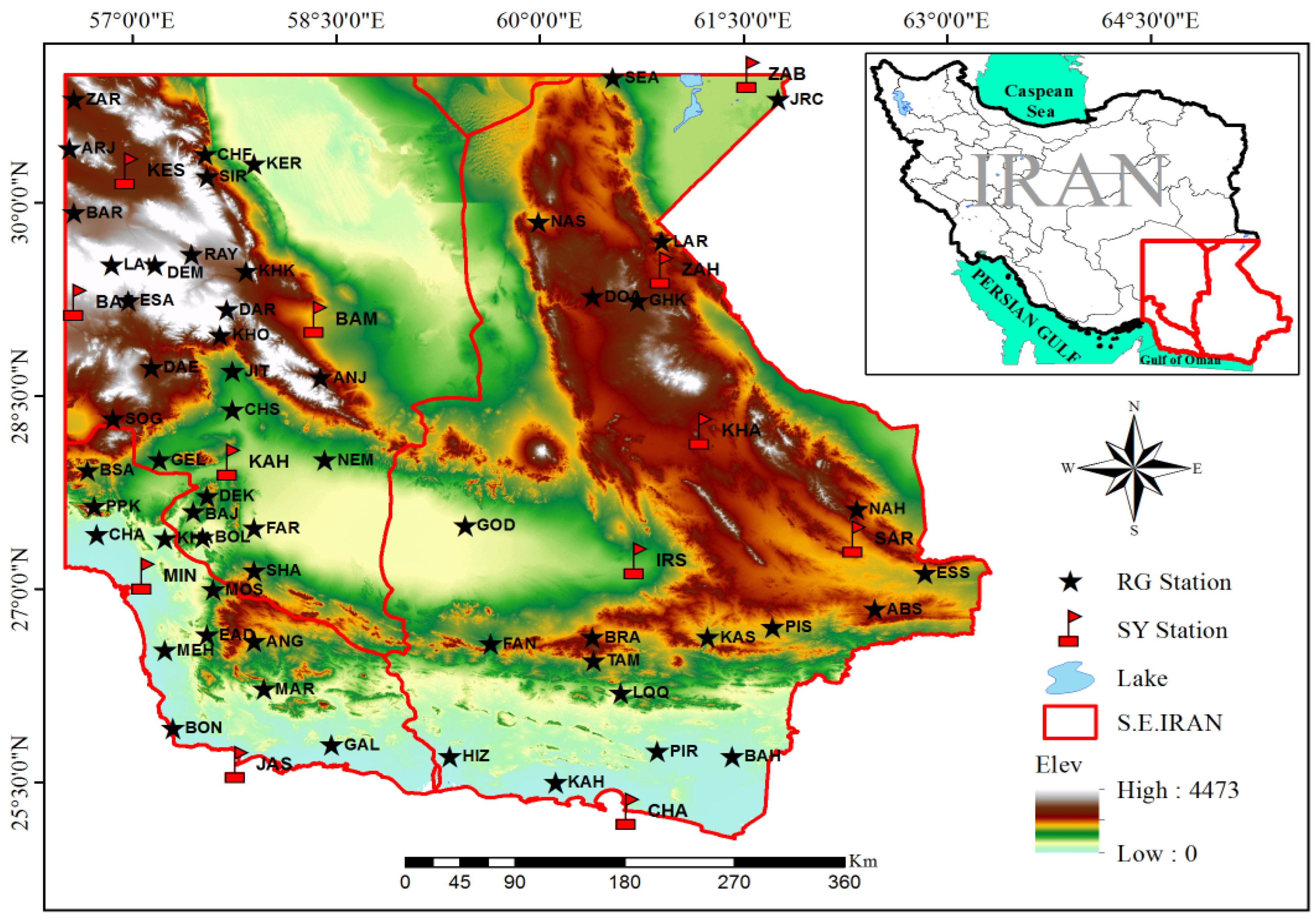
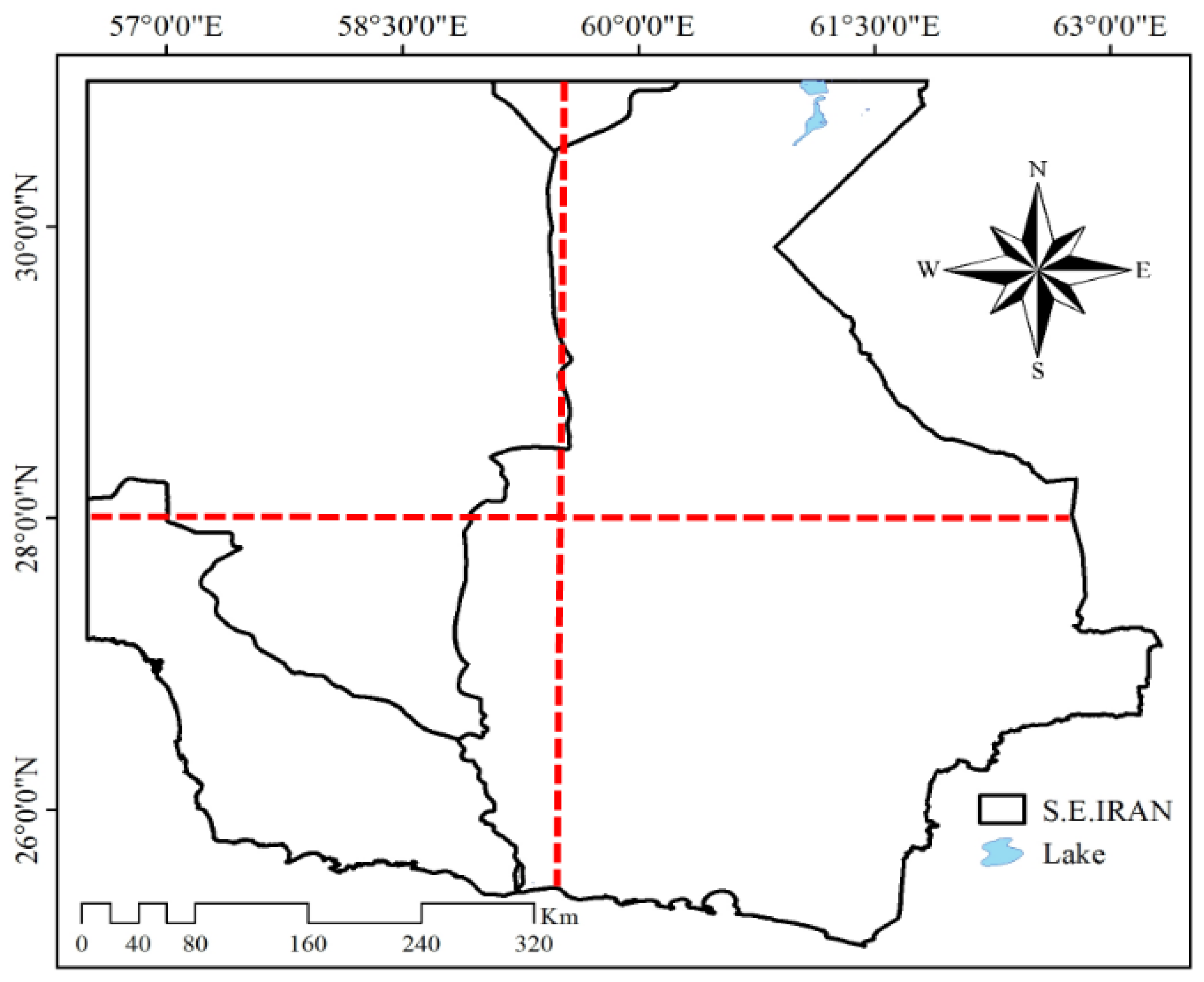


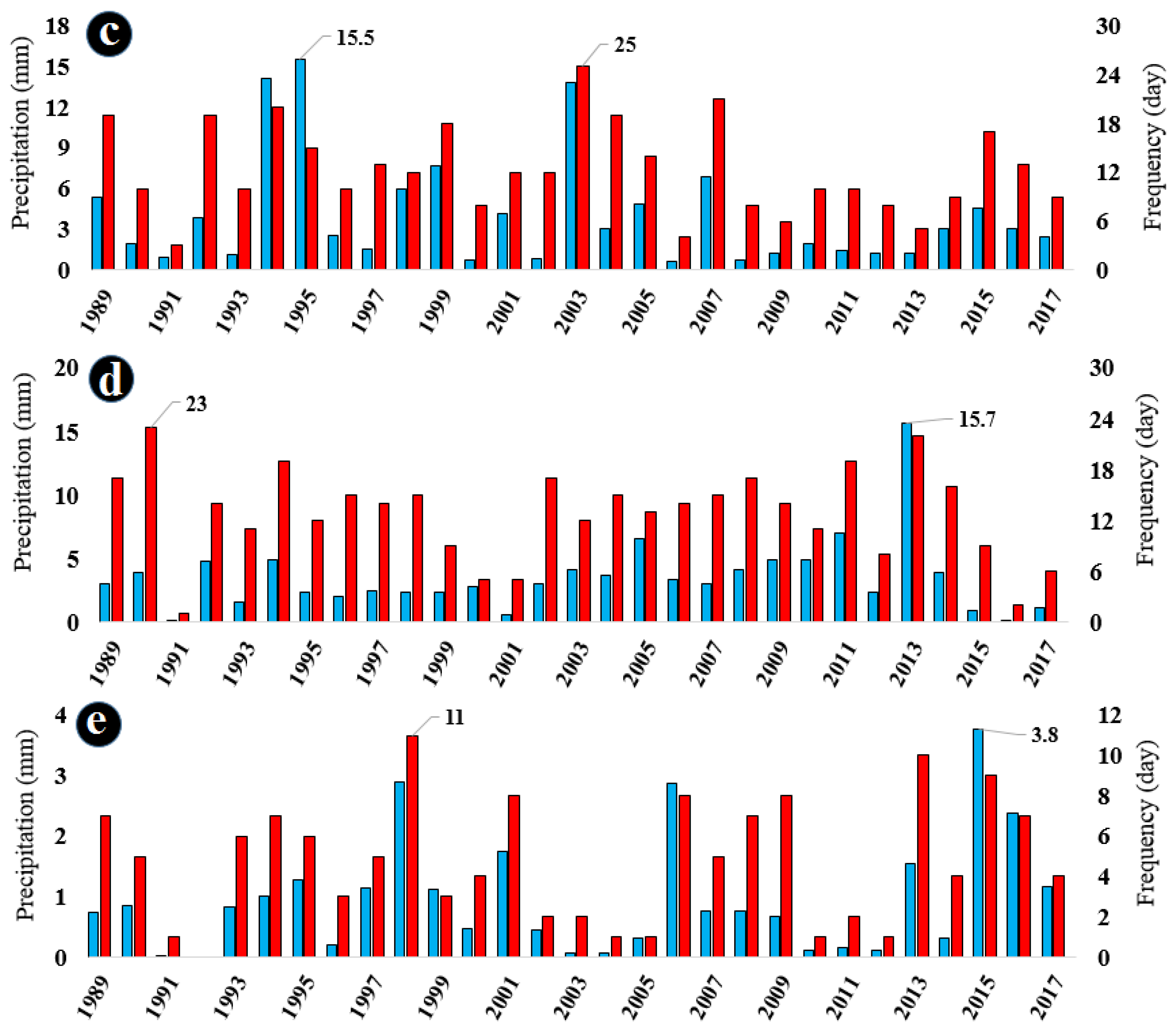

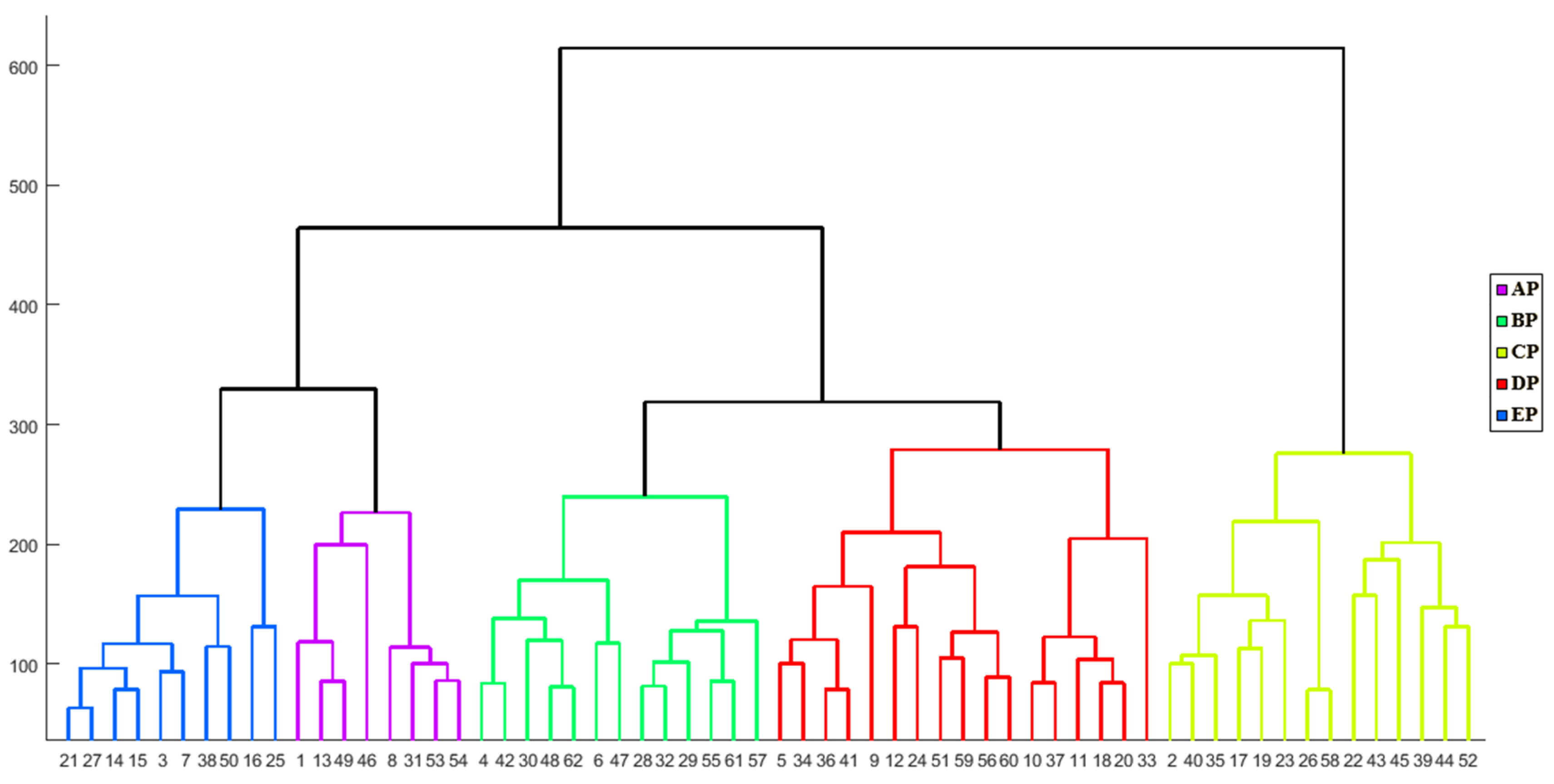
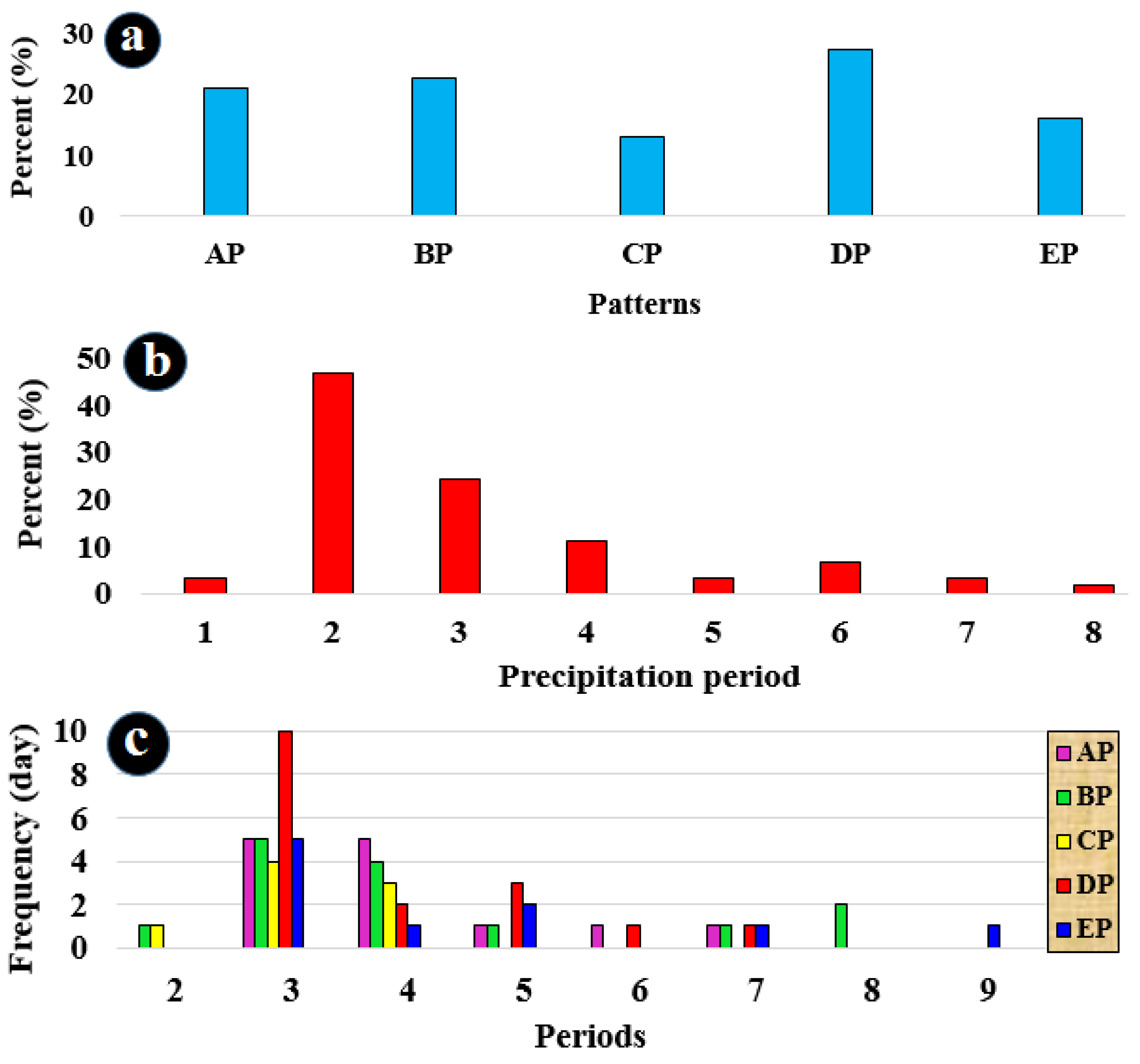


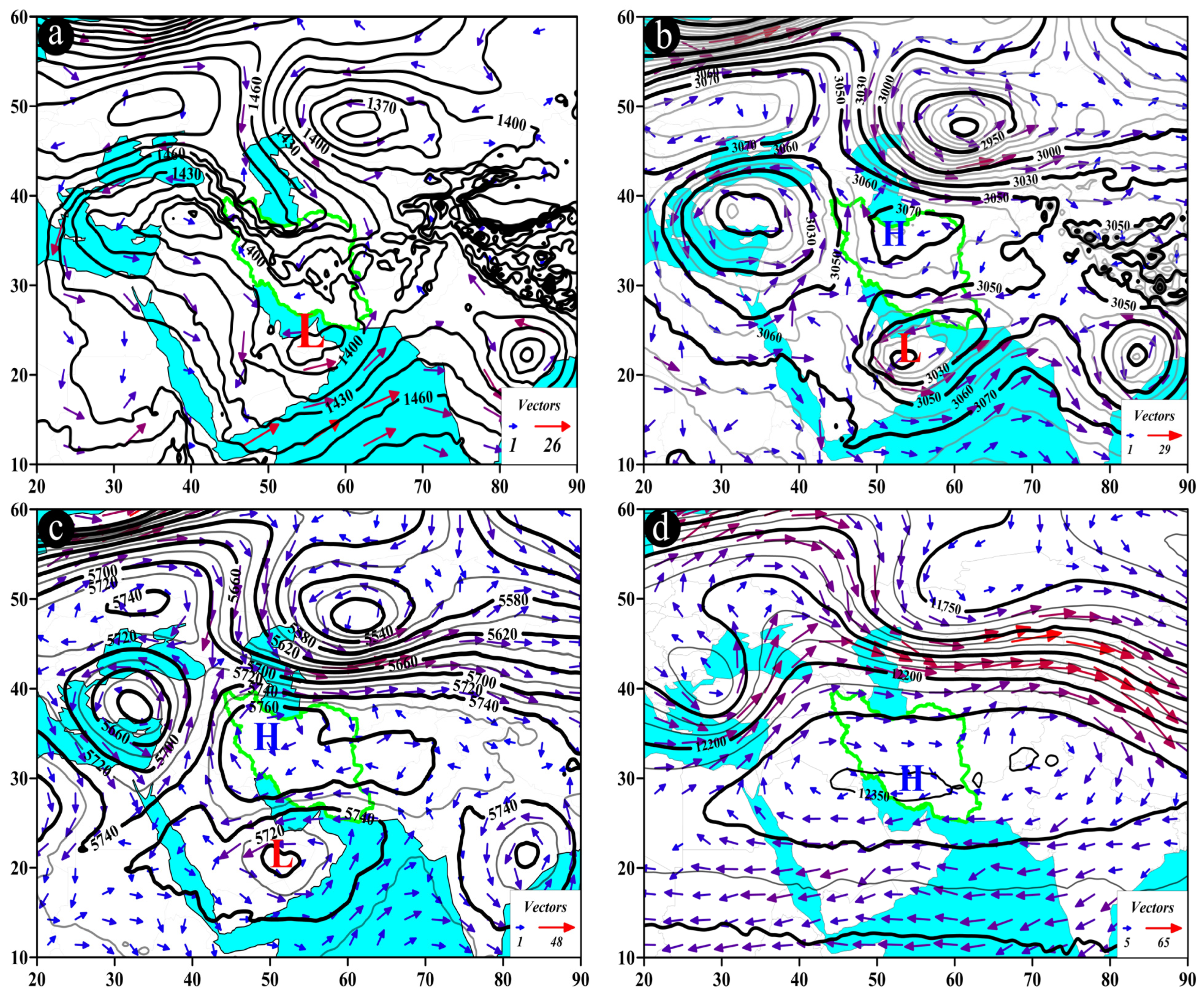
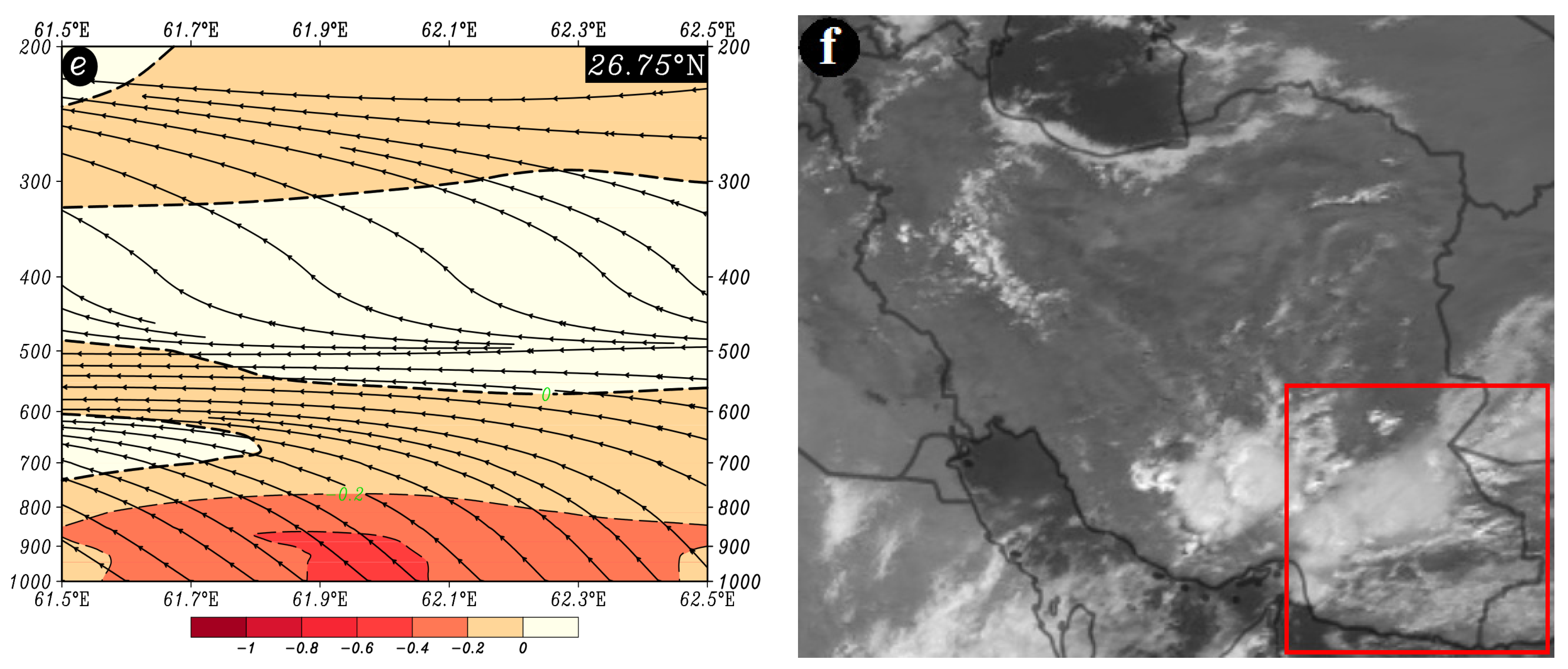


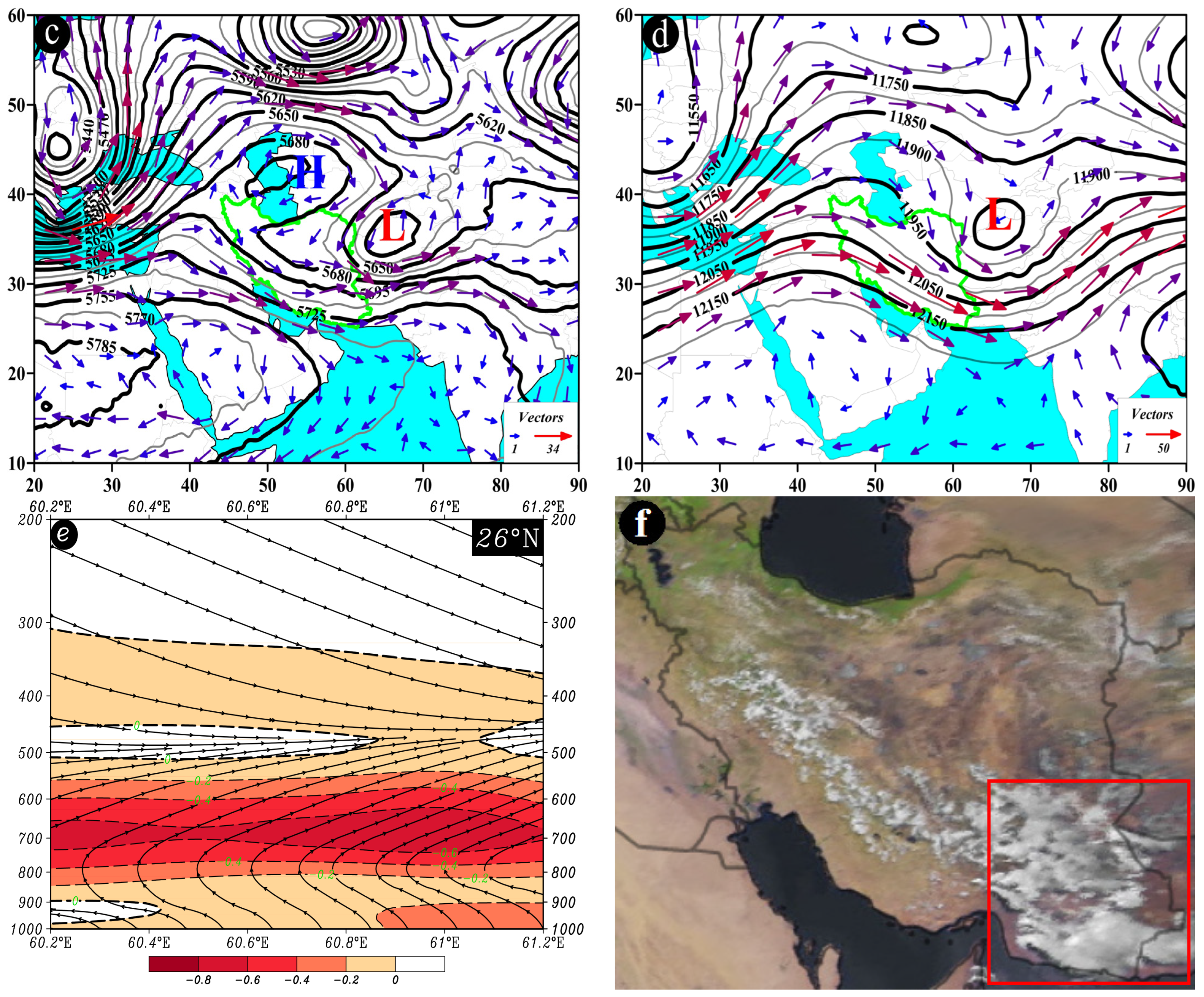
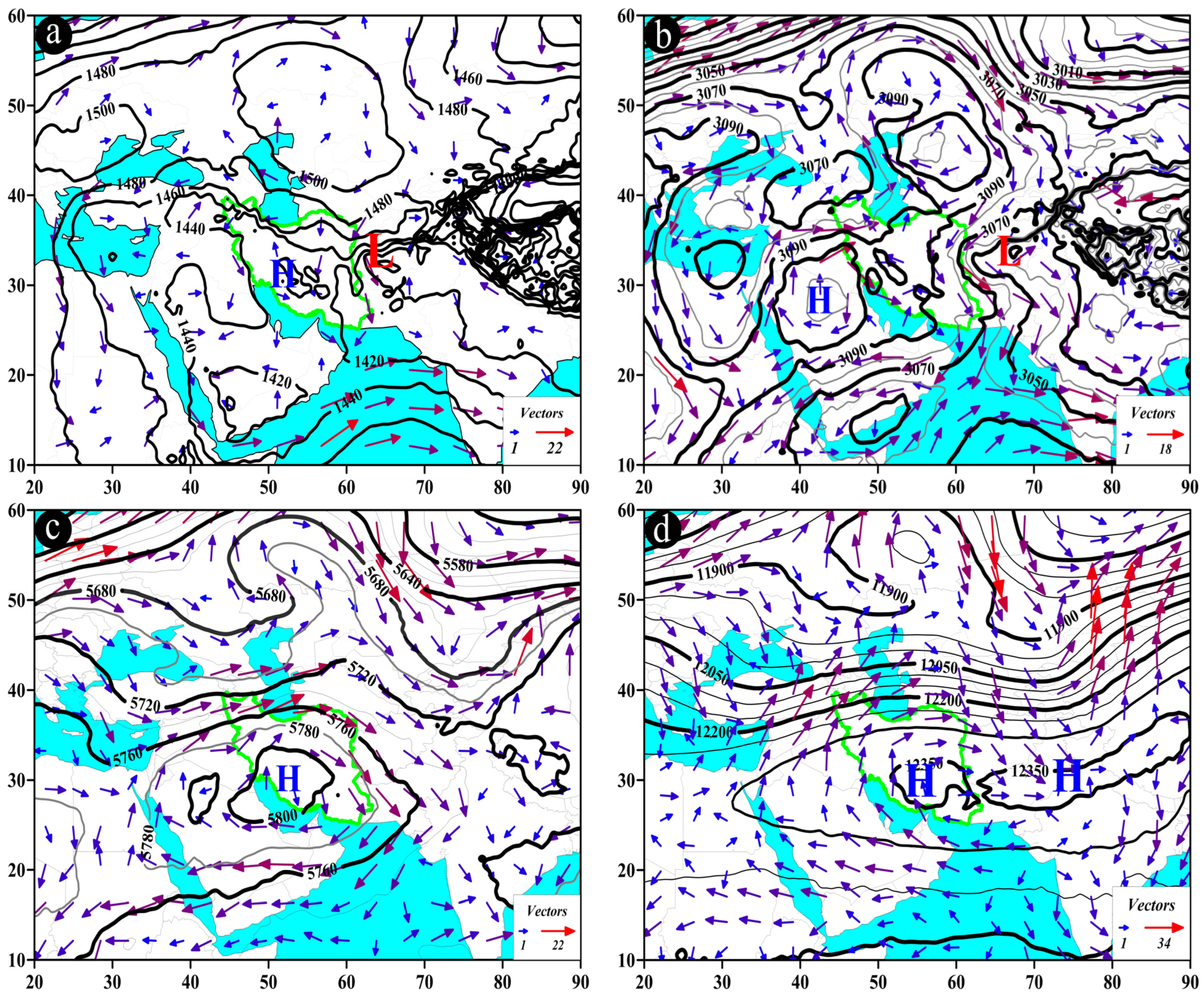
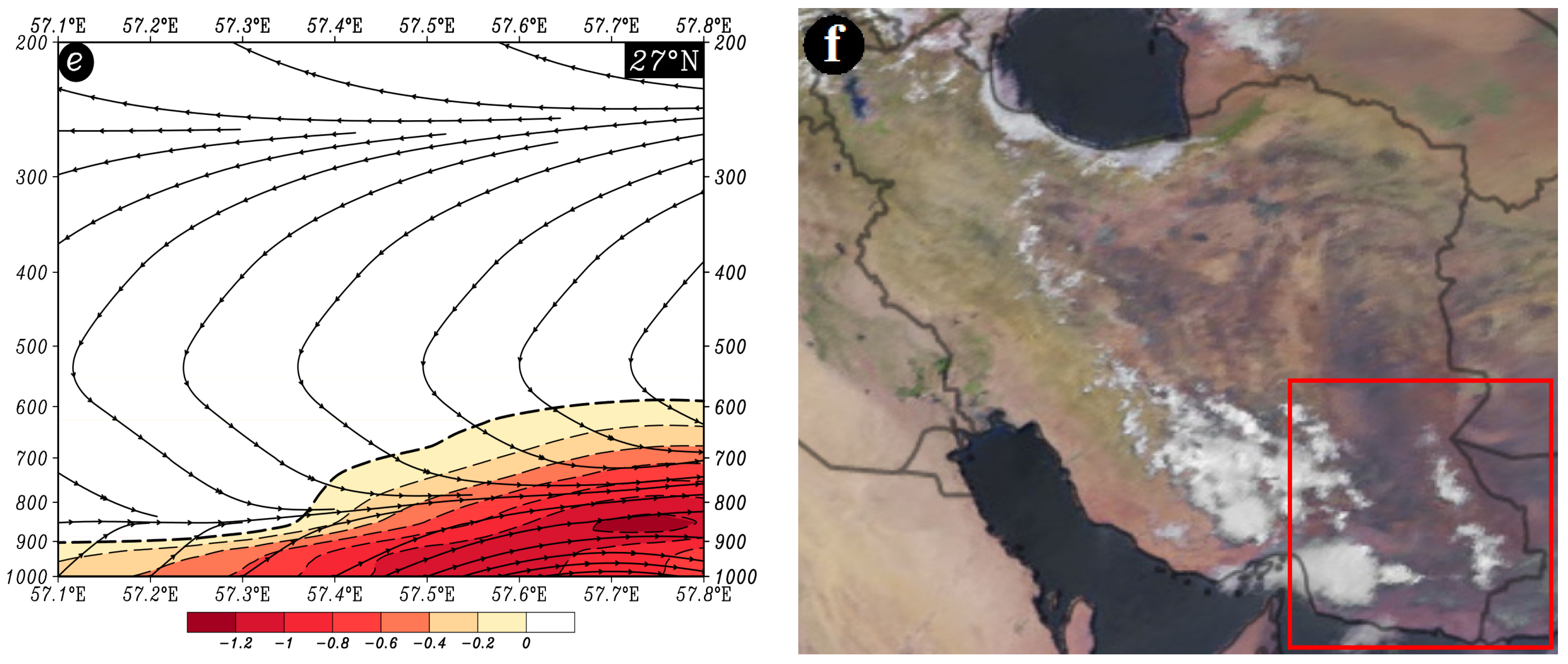
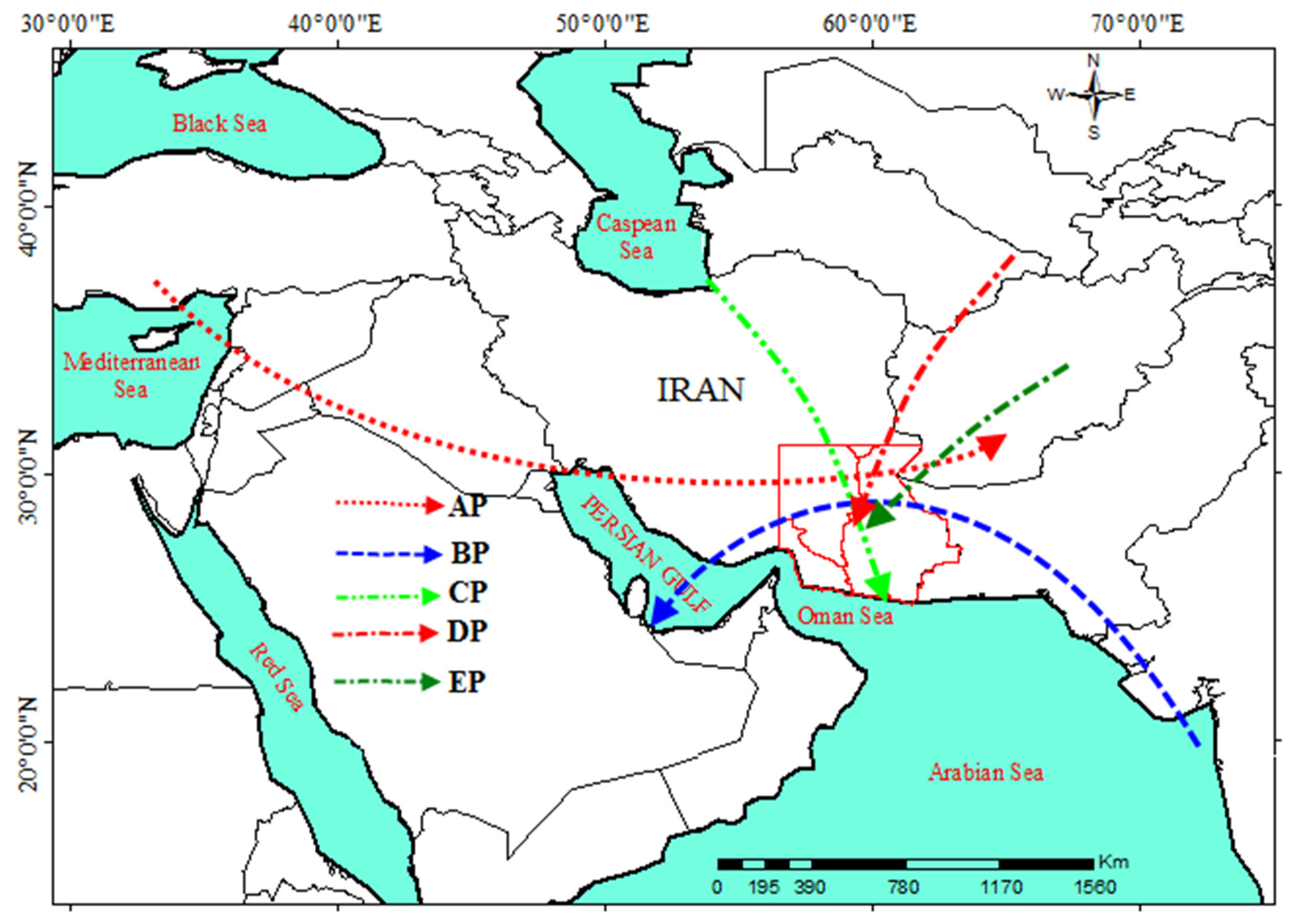
| Abbreviation | Station | Longitude | Latitude | Elevation (m) |
|---|---|---|---|---|
| BAF | Baft | 56.58 | 29.23 | 2280 |
| BAM | Bam | 58.35 | 29.1 | 1066.9 |
| CHA | Chabahar | 60.65 | 25.28 | 8 |
| IRS | Iranshahr | 60.71 | 27.22 | 591.1 |
| JAS | Jask | 57.77 | 25.64 | 5.2 |
| KAH | Kahnuj | 57.71 | 27.99 | 449 |
| KES | Kerman | 56.96 | 30.25 | 1754 |
| KHA | Khash | 61.19 | 28.23 | 1427 |
| MIN | Minab | 57.08 | 27.1 | 29.6 |
| SAR | Saravan | 62.32 | 27.39 | 1182 |
| ZAB | Zabol | 61.54 | 31 | 489.2 |
| ZAH | Zahedan | 60.9 | 29.48 | 1370 |
| Abbreviation | Station | Lon. | Lat. | Elev. (m) | Abbreviation | Station | Lon | Lat | Elev. (m) | Abbreviation | Station | Lon | Lat | Elev. (m) |
|---|---|---|---|---|---|---|---|---|---|---|---|---|---|---|
| ABS | Anarak Bamposht (Saravan) | 62.47 | 26.84 | 1260 | ESS | Esfandak-Saravan | 62.84 | 27.12 | 1073 | LAR | Lar paein | 60.9 | 29.7 | 1145 |
| ANG | Angoharan | 57.9 | 26.59 | 950 | EAD | Eslamabad Dorpahn | 57.55 | 26.64 | 470 | LQQ | Luriyani Qasr-e Qand | 60.6 | 26.19 | 405 |
| ANJ | Anjirak | 58.39 | 28.64 | 1435 | ESA | Esmaeilabad | 56.97 | 29.24 | 2201 | MAR | Marang | 57.97 | 26.22 | 360 |
| ARJ | Arjas | 56.54 | 30.42 | 2200 | FAN | Fanouj | 59.64 | 26.57 | 721 | MEH | Mehmani | 57.24 | 26.52 | 45 |
| BAH | Bahoukalat | 61.42 | 25.7 | 42 | FAR | Faryab | 57.9 | 27.47 | 300 | MOS | Moshkaldin | 57.6 | 26.99 | 660 |
| BAJ | Bajgan | 57.45 | 27.6 | 480 | GAL | Gabrik Lirei | 58.47 | 25.79 | 15 | NAH | Nahouk | 62.34 | 27.62 | 1335 |
| BAR | Bardsir | 56.57 | 29.92 | 2050 | GEL | Gelashgard | 57.2 | 28 | 570 | NEM | Nemdad Kouhestan | 58.42 | 28 | 470 |
| BSA | Barroud sargazahmadi | 56.67 | 27.92 | 980 | GHK | Ghatar khonjak | 60.72 | 29.24 | 1695 | NAS | Nosratabad Sistan | 59.99 | 29.85 | 1123 |
| BOL | Bolbolabad | 57.52 | 27.4 | 320 | GOD | Golmorti Delgan | 59.45 | 27.49 | 388 | PPK | Papar Poshtekoh | 56.72 | 27.64 | 400 |
| BON | Bounji | 57.3 | 25.92 | 10 | HIZ | Hiyan Zarabad | 59.34 | 25.7 | 23 | PIR | Pirsohrab | 60.87 | 25.74 | 68 |
| BRA | Braashk | 60.39 | 26.62 | 1235 | JIT | Jirouft | 57.74 | 28.69 | 684 | PIS | Pishin | 61.72 | 26.7 | 274 |
| CHA | Chah Aali | 56.74 | 27.42 | 30 | JRC | Jrikeh-Chahnimeh | 61.76 | 30.8 | 497 | RAY | Rayen | 57.44 | 29.6 | 2207 |
| CHF | Chahar Farsakh | 57.54 | 30.37 | 950 | KAH | Kahir | 60.12 | 25.5 | 20 | SEA | Sefidabad | 60.54 | 30.97 | 844 |
| CHS | Cheshmeh Shah | 57.74 | 28.39 | 566 | KAS | Kajdar Sarbaz | 61.24 | 26.62 | 885 | SHA | Sheykh AAli | 57.9 | 27.14 | 1760 |
| DAR | Darzin | 57.7 | 29.17 | 1334 | KER | Kerman | 57.9 | 30.3 | 1680 | SIR | Sirch | 57.55 | 30.2 | 1748 |
| DEK | Deh Kohan | 57.55 | 27.72 | 800 | KHK | Khaneh Khatun | 57.84 | 29.47 | 1766 | SOG | Soghan | 56.86 | 28.32 | 1500 |
| DEM | Deh Morteza | 57.17 | 29.52 | 2950 | KHA | Kharaji | 57.24 | 27.39 | 190 | TAM | Takht Malek | 60.4 | 26.44 | 816 |
| DOA | Domak Allahabad | 60.39 | 29.27 | 1491 | KHO | Khorramshahi | 57.65 | 28.97 | 1661 | ZAR | Zarand | 56.57 | 30.8 | 1680 |
| DAE | Dowlatabad-Esfandaqeh | 57.14 | 28.72 | 1734 | LAL | Lalehzar | 56.85 | 29.52 | 2830 |
Disclaimer/Publisher’s Note: The statements, opinions and data contained in all publications are solely those of the individual author(s) and contributor(s) and not of MDPI and/or the editor(s). MDPI and/or the editor(s) disclaim responsibility for any injury to people or property resulting from any ideas, methods, instructions or products referred to in the content. |
© 2023 by the authors. Licensee MDPI, Basel, Switzerland. This article is an open access article distributed under the terms and conditions of the Creative Commons Attribution (CC BY) license (https://creativecommons.org/licenses/by/4.0/).
Share and Cite
Mahoutchi, M.H.; Abbasi, E.; Khoshakhlagh, F.; Rousta, I.; Olafsson, H.; Baranowski, P.; Krzyszczak, J. Atmospheric Circulation Patterns during the Summertime Precipitation in Southeastern Iran. Atmosphere 2023, 14, 1673. https://doi.org/10.3390/atmos14111673
Mahoutchi MH, Abbasi E, Khoshakhlagh F, Rousta I, Olafsson H, Baranowski P, Krzyszczak J. Atmospheric Circulation Patterns during the Summertime Precipitation in Southeastern Iran. Atmosphere. 2023; 14(11):1673. https://doi.org/10.3390/atmos14111673
Chicago/Turabian StyleMahoutchi, Mohammad Hasan, Esmaeil Abbasi, Faramarz Khoshakhlagh, Iman Rousta, Haraldur Olafsson, Piotr Baranowski, and Jaromir Krzyszczak. 2023. "Atmospheric Circulation Patterns during the Summertime Precipitation in Southeastern Iran" Atmosphere 14, no. 11: 1673. https://doi.org/10.3390/atmos14111673






